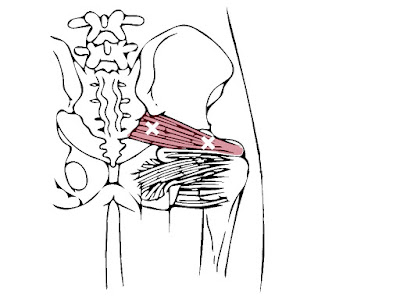Piriformis Trigger Points
Piriformis muscle is one of the six lateral rotators of the hip.
The piriformis muscle fibers are parallel to the lower gluteus maximus fibers. Having in mind that the attachments of these muscles adjacent it’s not surprising that piriformis muscle is a partner of the gluteus maximus in lateral rotation of the thigh.
What’s quite counterintuitive is the fact that piriformis becomes a medial rotator (rotates the femur inward) when the hip is flexed. Watch the video below to understand why.
Piriformis Trigger Points Chart
The most common trigger point location is the lateral site closer to the greater trochanter (the right cross on the picture below).
When gluteus maximus is weak a piriformis does a double work, which can be a reason for a trigger points formation.
Piriformis can be fatigued or overloaded by weight-bearing, usually involving a rotation of the hip.
Blunt trauma to the buttock is often cited as a cause of trigger points activation.- the piriformis muscle itself;
- the sciatic nerve entrapment in the area of the greater sciatic foramen caused by the muscle abnormal tension (neurogenic pain);
- both reasons.
Piriformis Referral Pain Pattern
The solid red zone is essential pain zone. The red stippling refers to "spillover pain zone" which may be absent.The neurogenic pain (caused by sciatic nerve entrapment) may spread down the whole posterior thigh, the calf, and even to the sole of the foot.



Nice article on trigger points. A trigger point in a muscle can cause strain and pain throughout the muscle. When this pain persists and worsens, doctors call it myofascial pain syndrome.
ReplyDelete